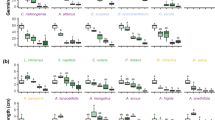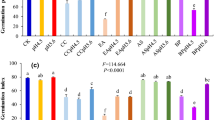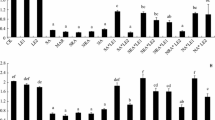Abstract
Allelopathic effects on the seed germination and seedling growth of the natives play a crucial role in the successful invasion of numerous invaders. Meanwhile, soil salinity is an emerging driver of the spread of many invaders, especially in the colonization of saline habitats. Thus, the allelopathic effects of the invaders on the seed germination and seedling growth of the natives may be altered or even reinforced under salt stress. This study aims to address the allelopathic effects of the notorious invader Canada goldenrod (Solidago canadensis L.; goldenrod hereafter) on the seed germination and seedling growth of the native lettuce (Lactuca sativa L.; lettuce hereafter) under a gradient of salt stress. Goldenrod leaf extracts with high concentration significantly decreased root length, leaf shape index, germination percentage, germination potential, germination index, germination vigor index, and germination rate index of lettuce. However, goldenrod leaf extracts with low concentration significantly increased root length and leaf width of lettuce. Goldenrod leaf extracts with high concentration display more serious allelopathic effects on the seed germination and seedling growth of lettuce than those with low concentration. Salt stress regardless of concentration significantly decreased seedling height, root length, leaf shape index, and seedling biomass (fresh weight) of lettuce. The combined goldenrod leaf extracts and salt stress have a synergistic effect on seedling height, root length, leaf shape index, germination percentage, germination potential, germination index, and germination rate index of lettuce. Thus, the allelopathic effects of the invaders on the seed germination and seedling growth of the natives may be reinforced under salt stress. Accordingly, salt stress may be beneficial to the further invasion of the invaders mainly via the reduced growth performance of the natives.






Similar content being viewed by others
References
Abhilasha D, Quintana N, Vivanco J, Joshi J (2008) Do allelopathic compounds in invasive Solidago canadensis s.l. restrain the native European flora? J Ecol 96:993–1001
An M (2005) Mathematical modelling of dose-response relationship (hormesis) in allelopathy and its application. Nonlinear Biol Toxicol Med 3:153–172
Callaway RM, Ridenour WM (2004) Novel weapons: invasive success and the evolution of increased competitive ability. Front Ecol Environ 2:436–443
Chaugool J, Naito H, Kasuga S, Ehara H (2013) Comparison of young seedling growth and sodium distribution among sorghum plants under salt stress. Plant Prod Sci 16:261–270
Dong M, Lu BR, Zhang HB, Chen JK, Li B (2006) Role of sexual reproduction in the spread of an invasive clonal plant Solidago canadensis revealed using intersimple sequence repeat markers. Plant Species Biol 21:13–18
Duke SO, Cedergreen N, Velini ED, Belz RG (2006) Hormesis: is it an important factor in herbicide use and allelopathy? Outlooks Pest Manag 17:29–33
Hang ZH, Wu HP (2017) In: Ye ZG, Yang ZH, Pan Y, Zhao YL (Eds). Zhenjiang Yearbook: Overview of Zhenjiang (The first edition). Organized by Zhenjiang Municipal People’s Government & Writed by Zhenjiang Local Records Office, vol 26. Publishing House of Local Records, Beijing, pp 30–31
Hossain MK, Anwar S, Nandi R (2016) Allelopathic effects of Mikania cordata on forest and agricultural crops in Bangladesh. J Res 27:155–159
Hou QQ, Chen BM, Peng SL, Chen LY (2014) Effects of extreme temperature on seedling establishment of nonnative invasive plants. Biol Invasions 16:2049–2061
Hu G, Zhang ZH (2013) Aqueous tissue extracts of Conyza canadensis inhibit the germination and shoot growth of three native herbs with no autotoxic effects. Planta Daninha 31:805–811
Hu GF, Liu YM, Zhang XZ, Yao FJ, Huang Y, Ervin EH, Zhao BY (2015) Physiological evaluation of alkali-salt tolerance of thirty switchgrass (Panicum virgatum) Lines. PLoS One 10:e125305
Jeong N, Moon J, Kim H, Kim C, Jeong S (2011) Fine genetic mapping of the genomic region controlling leaflet shape and number of seeds per pod in the soybean. Theor Appl Genet 122:865–874
Kuhn NL, Zedler JB (1997) Differential effects of salinity and soil saturation on native and exotic plants of a coastal salt marsh. Estuar Coast 20:391–403
Li JM, Liao JJ, Guan M, Wang EF, Zhang J (2012) Salt tolerance of Hibiscus hamabo seedlings: a candidate halophyte for reclamation areas. Acta Physiol Plant 34:1747–1755
Li JM, Liu HY, Yan M, Du LS (2017) No evidence for local adaptation to salt stress in the existing populations of invasive Solidago canadensis in China. PLoS One 12:e175252
Lin WX, Kim KU, Smin DH (2000) Rice allelopathic potential and its modes of action on barnyardgrass (Echinochloa crus-galli). Allelopath J 7:215–224
Morais MC, Panuccio MR, Muscolo A, Freitas H (2012) Does salt stress increase the ability of the exotic legume Acacia longifolia to compete with native legumes in sand dune ecosystems? Environ Exp Bot 82:74–79
Parida AK, Das AB (2005) Salt tolerance and salinity effects on plants: a review. Ecotox Environ Safet 60:324–349
Prati D, Bossdorf O (2004) Allelopathic inhibition of germination by Alliaria petiolata (Brassicaceae). Am J Bot 91:285–288
Prithiviraj B, Perry LG, Badri DV, Vivanco JM (2007) Chemical facilitation and induced pathogen resistance mediated by a root-secreted phytotoxin. New Phytol 173:852–860
Rouifed S, Byczek C, Laffray D, Piola F (2012) Invasive knotweeds are highly tolerant to salt stress. Environ Manag 50:1027–1034
Schmer MR, Xue Q, Hendrickson JR (2012) Salinity effects on perennial, warm-season (C4) grass germination adapted to the northern Great Plains. Can J Plant Sci 92:873–881
Steinmaus SJ, Timonthy SP, Jodie SH (2000) Estimation of base temperature for nine weed species. J Exp Bot 51:275–286
Svensson JR, Nylund GM, Cervin G, Toth GB, Pavia H (2013) Novel chemical weapon of an exotic macroalga inhibits recruitment of native competitors in the invaded range. J Ecol 101:140–148
Takao LK, Ribeiro JPN, Lima MIS (2011) Allelopathic effects of Ipomoea cairica (L.) Sweet on crop weeds. Acta Bot Bras 25:858–864
Turk MA, Tawaha AM (2003) Allelopathic effect of black mustard (Brassica nigra L.) on germination and growth of wild oat (Avena fatua L.). Crop Prot 22:673–677
Xu XQ, Wang YY, Lu Q, Lin ZH, Chen HL (2011) Effect of Solidago canadensis invasions on soil nematode communities in Hangzhou Bay. Biodivers Sci 19:519–527
Vasquez EA, Glenn EP, Guntenspergen GR, Brown JJ (2006) Salt toterance and osmotic adjustment of Spartina alterniflora (Poaceae) and the invasive M haplotype of Phragmites australis (Poaceae) along a salinity gradient. Am J Bot 93:1784–1790
Viator RP, Johnson RM, Grimm CC, Richard EP (2006) Allelopathic, autotoxic, and hormetic effects of postharvest sugarcane residue. Agr J 98:1526–1531
Wang CY, Xiao HG, Zhao LL, Liu J, Wang L, Zhang F, Shi YC, Du DL (2016a) The allelopathic effects of invasive plant Solidago canadensis on seed germination and growth of Lactuca sativa enhanced by different types of acid deposition. Ecotoxicology 25:555–562
Wang CY, Liu J, Xiao HG, Zhou JW, Du DL (2016b) Floristic characteristics of alien invasive seed plant species in China. Acad Bras Ciênc 88:1791–1797
Wang CY, Zhou JW, Liu J, Jiang K, Du DL (2017a) Responses of soil N-fixing bacteria communities to Amaranthus retroflexus invasion under different forms of N deposition. Agr Ecosyst Environ 247:329–336
Wang CY, Zhou JW, Liu J, Du DL (2017b) Responses of soil N-fixing bacteria communities to invasive species over a gradient of simulated nitrogen deposition. Ecol Eng 98:32–39
Wang CY, Liu J, Xiao HG, Zhou JW, Du DL (2017c) Nitrogen deposition influences the allelopathic effect of an invasive plant on the reproduction of a native plant: Solidago canadensis versus Pterocypsela laciniata. Pol J Ecol 65:87–96
Wang CY, Zhou JW, Jiang K, Liu J (2017d) Differences in leaf functional traits and allelopathic effects on seed germination and growth of Lactuca sativa between red and green leaves of Rhus typhina. S Afr J Bot 111:17–22
Wang CY, Liu J, Zhou JW (2017e) N deposition affects allelopathic potential of Amaranthus retroflexus with different distribution regions. Acad Bras Ciênc 89:919–926
Wang CY, Jiang K, Zhou JW, Liu J (2017f) Allelopathic suppression by Conyza canadensis depends on the interaction between latitude and the degree of the plant’s invasion. Acta Bot Bras 31:212–219
Wang CY, Zhou JW, Liu J, Jiang K, Xiao HG, Du DL (2018a) Responses of the soil fungal communities to the co-invasion of two invasive species with different cover classes. Plant Biol 20:151–159
Wang CY, Jiang K, Liu J, Zhou JW, Wu BD (2018b) Moderate and heavy Solidago canadensis L. invasion are associated with decreased taxonomic diversity but increased functional diversity of plant communities in East China. Ecol Eng 112:55–64
Wang CY, Jiang K, Zhou JW, Wu BD (2018c) Solidago canadensis invasion affects soil N-fixing bacterial communities in heterogeneous landscapes in urban ecosystems in East China. Sci Total Environ 631–632:702–713
Wang CY, Jiang K, Wu BD, Zhou JW, Lv YN (2018d) Silver nanoparticles with different particle sizes enhance the allelopathic effects of Canada goldenrod on the seed germination and seedling development of lettuce. Ecotoxicology 27:1116–1125
Wang Z, Zhang L (2012) Leaf shape alters the coefficients of leaf area estimation models for Saussurea stoliczkai in central Tibet. Photosynthetica 50:337–342
Williamson GB, Richardson D (1988) Bioassays for allelopathy: measuring treatment responses with independent controls. J Chem Ecol 14:181–187
Yan XL, Liu QR, Shou HY, Zeng XF, Zhang Y, Chen L, Liu Y, Ma HY, Qi SY, Ma JS (2014) The categorization and analysis on the geographic distribution patterns of Chinese alien invasive plants. Biodivers Sci 22:667–676. (In Chinese)
Yang RY, Mei LX, Tang JJ, Chen X (2007) Allelopathic effects of invasive Solidago canadensis L. on germination and root growth of native Chinese plants. Allelopath J 19:241–248
Ye XQ, Wu M, Shao X, Liang L (2014) Effects of water extracts from Solidago canadensis on the growth of maize seedlings and the underlying photosynthetic mechanism. Acta Prataculturae Sin 23:217–224.
Yuan YG, Wang B, Zhang SS, Tang JJ, Tu C, Hu SJ, Yong JWH, Chen X (2013) Enhanced allelopathy and competitive ability of invasive plant Solidago canadensis in its introduced range. J Plant Ecol 6:253–263
Zhang SS, Zhu WJ, Wang B, Tang JJ, Chen X (2011) Secondary metabolites from the invasive Solidago canadensis L. accumulation in soil and contribution to inhibition of soil pathogen Pythium ultimum. Appl Soil Ecol 48:280–286
Zhao SY, Sun SG, Dai C, Gituru RW, Chen JM, Wang QF (2015) Genetic variation and structure in native and invasive Solidago canadensis populations. Weed Res 55:163–172
Acknowledgements
We are very grateful to the anonymous reviewers for the insightful and constructive comments that greatly improved this manuscript.
Funding
This study was supported by National Key Research & Development Program of China (2016YFC0502002), National Natural Science Foundation of China (31300343), and Jiangsu Collaborative Innovation Center of Technology and Material of Water Treatment.
Author information
Authors and Affiliations
Corresponding author
Ethics declarations
Conflict of interest
The authors declare that they have no conflict of interest.
Ethical approval
This article does not contain any studies with animals performed by any of the authors.
Informed consent
Informed consent was obtained from all individual participants included in the study.
Supplementary Information
Rights and permissions
About this article
Cite this article
Wang, C., Wu, B. & Jiang, K. Allelopathic effects of Canada goldenrod leaf extracts on the seed germination and seedling growth of lettuce reinforced under salt stress. Ecotoxicology 28, 103–116 (2019). https://doi.org/10.1007/s10646-018-2004-7
Accepted:
Published:
Issue Date:
DOI: https://doi.org/10.1007/s10646-018-2004-7




